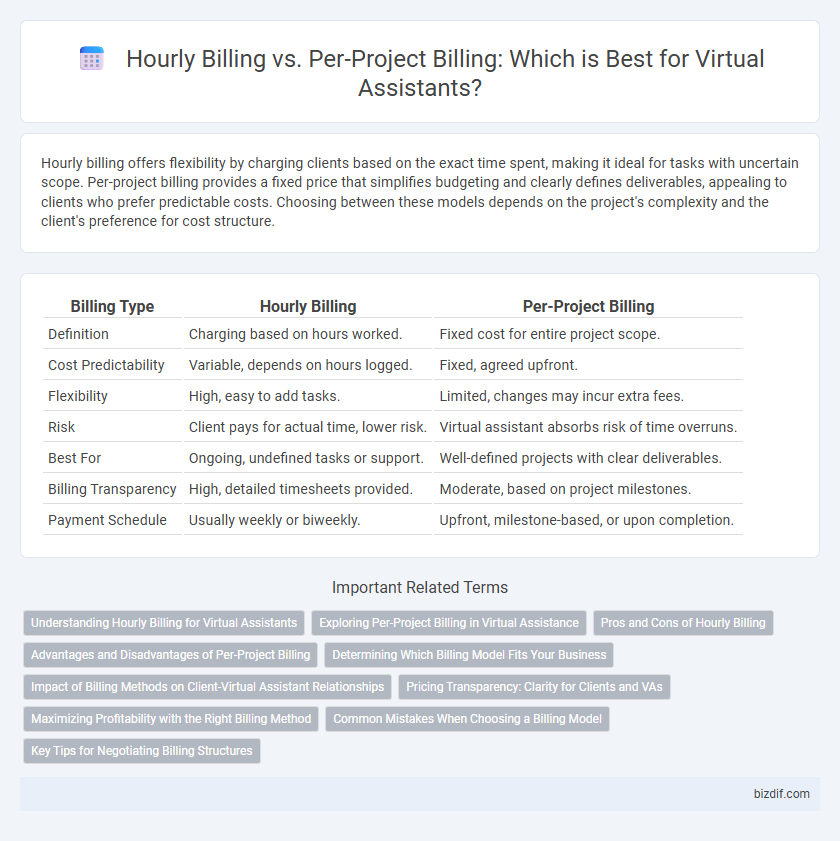Hourly billing offers flexibility by charging clients based on the exact time spent, making it ideal for tasks with uncertain scope. Per-project billing provides a fixed price that simplifies budgeting and clearly defines deliverables, appealing to clients who prefer predictable costs. Choosing between these models depends on the project's complexity and the client's preference for cost structure.
Table of Comparison
| Billing Type | Hourly Billing | Per-Project Billing |
|---|---|---|
| Definition | Charging based on hours worked. | Fixed cost for entire project scope. |
| Cost Predictability | Variable, depends on hours logged. | Fixed, agreed upfront. |
| Flexibility | High, easy to add tasks. | Limited, changes may incur extra fees. |
| Risk | Client pays for actual time, lower risk. | Virtual assistant absorbs risk of time overruns. |
| Best For | Ongoing, undefined tasks or support. | Well-defined projects with clear deliverables. |
| Billing Transparency | High, detailed timesheets provided. | Moderate, based on project milestones. |
| Payment Schedule | Usually weekly or biweekly. | Upfront, milestone-based, or upon completion. |
Understanding Hourly Billing for Virtual Assistants
Hourly billing for virtual assistants involves charging clients based on the actual time spent on tasks, providing transparent and flexible cost management. This method allows precise tracking of hours worked, making it ideal for projects with variable or ongoing workloads. Virtual assistants using hourly billing often utilize time-tracking tools to ensure accurate invoicing and maintain trust with clients.
Exploring Per-Project Billing in Virtual Assistance
Per-project billing in virtual assistance enables clients to receive a clear, upfront cost for specific deliverables, enhancing budget predictability and project scope clarity. This model incentivizes virtual assistants to focus on efficiency and quality, as payment is tied to project completion rather than time spent. Virtual assistants specializing in tasks such as social media management, content creation, or administrative support benefit from per-project billing by aligning their services with client goals and measurable outcomes.
Pros and Cons of Hourly Billing
Hourly billing offers flexibility by allowing clients to pay only for the exact time spent on tasks, promoting transparency and adaptability in project scope. However, it can lead to budget unpredictability and may incentivize inefficiency, as the final cost depends on the duration rather than fixed outcomes. Time-tracking accuracy is critical, and disputes may arise if clients question the logged hours or task complexity.
Advantages and Disadvantages of Per-Project Billing
Per-project billing offers clear budget expectations and scope definition, reducing the risk of unexpected costs and fostering accountability in virtual assistant services. This method can streamline payment and project management but may lead to scope creep if project boundaries are not well-defined. However, it lacks flexibility for ongoing support or changing requirements compared to hourly billing.
Determining Which Billing Model Fits Your Business
Choosing between hourly billing and per-project billing for virtual assistant services depends on the specific workload and client preferences. Hourly billing suits tasks with variable time requirements, offering flexibility and precise compensation for time spent. Per-project billing benefits defined scopes with clear deliverables, ensuring predictable costs and streamlined budgeting for clients.
Impact of Billing Methods on Client-Virtual Assistant Relationships
Hourly billing fosters transparency through real-time tracking of tasks, which can build trust between clients and virtual assistants by aligning efforts with compensation. Per-project billing offers predictability in costs, enhancing client satisfaction but may risk scope misunderstandings without clear agreements. Selecting the appropriate billing method directly affects communication clarity, expectation management, and long-term collaboration success in virtual assistant engagements.
Pricing Transparency: Clarity for Clients and VAs
Hourly billing provides clear, real-time tracking of work hours, allowing clients and virtual assistants to monitor payments based on actual time spent. Per-project billing offers a fixed cost upfront, giving clients a predictable budget but less visibility into the time investment from VAs. Clear communication of pricing models and expectations ensures transparency, building trust and preventing disputes.
Maximizing Profitability with the Right Billing Method
Choosing the right billing method, hourly billing or per-project billing, significantly impacts profitability for virtual assistants. Hourly billing ensures compensation for all time spent, ideal for tasks with variable scope, while per-project billing encourages efficiency and predictable income on defined deliverables. Analyzing client needs, project complexity, and time management enables virtual assistants to maximize profits by selecting the model best aligned with their workflow.
Common Mistakes When Choosing a Billing Model
Choosing between hourly billing and per-project billing often leads to common mistakes such as underestimating project scope or failing to track hours accurately, resulting in lost revenue or scope creep. Many virtual assistants overlook the importance of aligning billing models with client expectations and project complexity, which can cause misunderstandings and dissatisfaction. Proper evaluation of project requirements and transparent communication help avoid billing disputes and improve client trust.
Key Tips for Negotiating Billing Structures
When negotiating billing structures for virtual assistant services, clearly define the scope of work and expected deliverables to choose between hourly billing and per-project billing. Emphasize transparent communication on time estimates and potential scope changes to avoid misunderstandings. Leverage detailed contracts that specify payment terms, milestones, and revision policies for smoother collaboration and fair compensation.
Hourly billing vs Per-project billing Infographic

 bizdif.com
bizdif.com